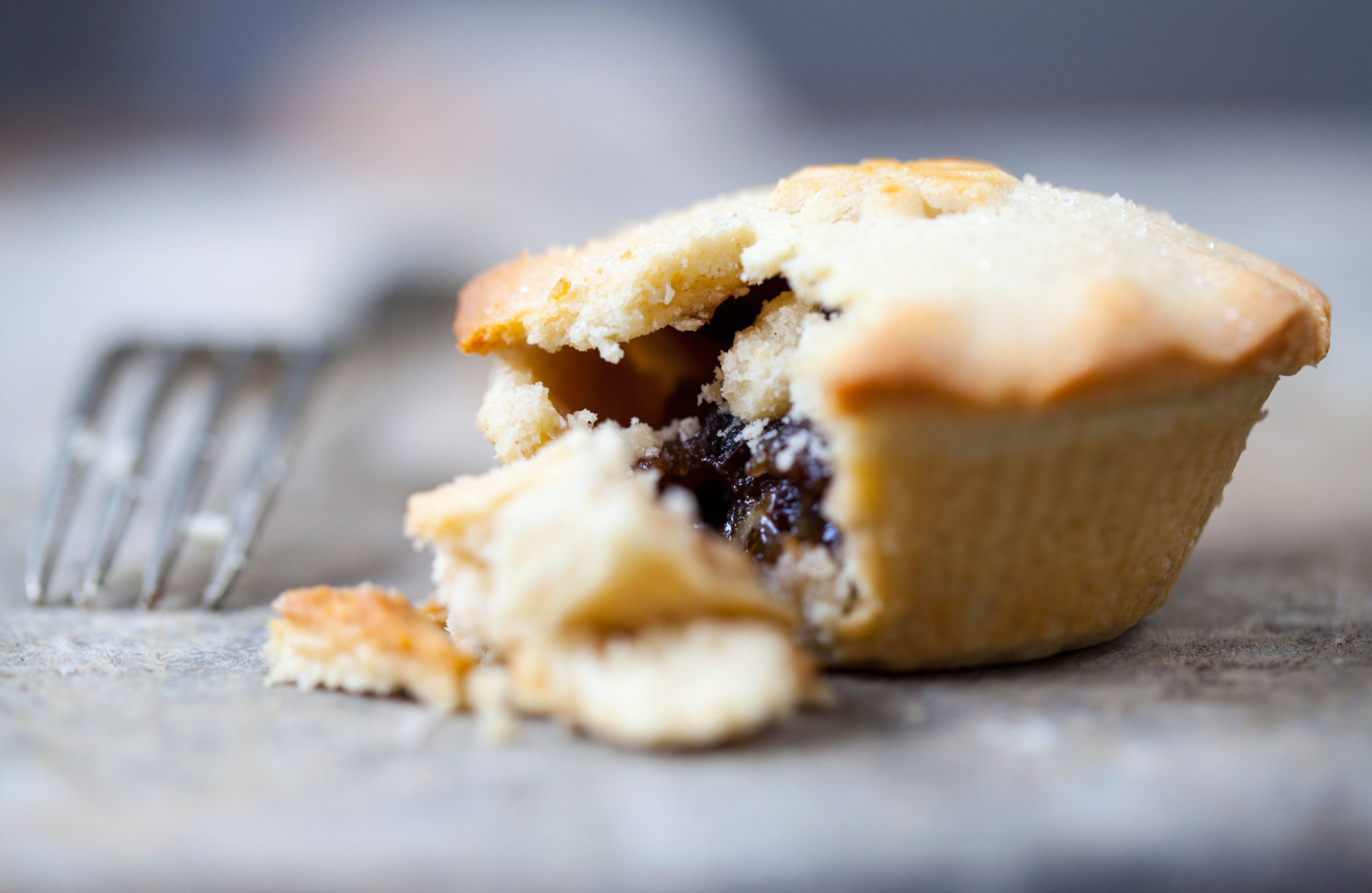Curious Questions: Did mince pies really once contain meat?
Martin Fone investigates the most traditional seasonal food of all: mince pies.


For a quarter of Britons, the first mouthful of a mince pie, a delicious concoction of buttery, crumbly pastry filled with spiced mincemeat and flavoured with a generous dash of liquor, marks the start of the Yuletide season, a treat to be reserved until the first door of the Advent calendar creaks open. After that, there is no holding back, with 800 million of them eaten each year, usually served warm rather than cold and with cream or brandy butter as an accompaniment. Second only to pigs in blankets as festive favourites, we spend around £100m a year on mince pies.
While the idea of mixing meat with dried fruit and spices was a by-product of the Crusades, pies, particularly those containing finely chopped meat, were already firmly on the British menu. The ‘coffyn’, a pastry case made of flour and water, was so solid after the ingredients inside it had cooked that it was barely edible and was often discarded to be distributed to the poor or fed to the animals. Aside from adding extra flavour and masking meat past its prime, spices were thought to preserve the pie so that it could be eaten up to a year after baking, the pastry also acting as a formidable barrier to unwelcome microbes and vermin.
An early recipe for such a pie is recorded in the Forme of Cury (1390), a compendium of English recipes produced by Richard II’s master cooks. ‘Tartes of flesh’ were made by boiling pork and then grinding it along with hard-boiled eggs and cheese into small pieces. Powders, whole spices, saffron, sugar, and salt were mixed in and placed in the pastry casement. Before the pie was sealed, a top layer consisting of ground pieces of meat from small, stewed birds (species unspecified) and rabbit was added. The pie was then baked.

Each pie was large and oblong, enough to feed a family and guests in one sitting. Although the royal cooks used pork, mutton was more normally used. Intended to be eaten during the winter, the pies were expensive to make as the spices had to be imported, making them beyond the reach of all but the rich.
Consequently, they were often reserved for important religious occasions, such as Christmas, and became known as Christmas or December pies. They began to assume a religious significance, the oblong shape representing the crib of the baby Jesus, the pastry topping was folded to become swaddling clothes and a pastry Jesus placed on top. The pie’s thirteen ingredients symbolised Christ and his twelve disciples and the spices the gifts brought by the Magi.
By the time that Gervase Markham published his recipe in The English Huswife in 1615, pastry had become more edible, thanks to the addition of fat to the flour and water mix and was now enjoyed as part of the pie. Markham’s recipe called for an entire leg of mutton and three pounds of suet which were mixed with salt, cloves, mace, currants, raisins, prunes, dates, and orange peel, a list of ingredients that, save for the meat, which is remarkably like that used today.
Cooks and bakers in the 17th century were keen to explore the potential of the pie, becoming ever more adventurous with their recipes. Thomas Dawson delighted his readers in The Good Housewife’s Jewel (1598) with a recipe for a spiced pie using the humbles or innards of a deer, while others used one or more of tongue, lamb’s stones otherwise known as testicles, udder, and tripe. Instead of meat some used fish, Markham including a recipe featuring pickled herring, while Robert May in 1660 put salmon, eel, and sturgeon in the same spiced pie.
Exquisite houses, the beauty of Nature, and how to get the most from your life, straight to your inbox.

Reflecting this spirit of experimentation, by Tudor times the spiced meat pie had become known as Shrid pie, a variant of which, Shred, was used as late as 1699 by Cumbrian chef, Elizabeth Brown, in her handwritten recipe book. The first recorded reference to mince pies, curiously, appeared in a document from 1624, locked away in the state papers of King Charles I’s then secretary of state, Edward Conway. It gives a recipe for ‘six Minst pyes of indifferent bigness’, the word ‘mince’ derived from the Middle English verb for chopping finely, ‘mincen’. Of indifferent bigness they might have been to Conway, but the mix comfortably makes twenty-four modern-day mince pies.
There is no evidence that mince pies fell victim to Oliver Cromwell’s crack down on religious feasts and ceremonies, but that did not prevent his critics after the Restoration from claiming that he saw their rich and decadent spices as the epitome of Popery. A rhyme from 1661 fixed the canard in the popular imagination; ‘all plums the Prophet’s sons defy/ and spice broth’s are too hot/ treason’s in a December-pye/ and death within the pot’. Fake news is nothing new.
On Christmas Eve, 1663, Samuel Pepys noted in his diary that when he returned home, he found his wife making mince pies, while, three years later, on Christmas Day he went to church alone, ‘leaving my wife desirous to sleep, having sat up till four this morning seeing her mayds make mince-pies’. On his return he ‘dined well on some good ribs of beef roasted and mince pies’. Mince pies were not just reserved for Christmas. Attending a friend’s anniversary party, Pepys recorded that the centre piece were eighteen mince pies, one to mark each year of connubial bliss.
By the 18th century cheaper cuts of meat such as tongue and tripe replaced the traditional mutton, pork, or beef, and around the middle of the century an even more important change occurred, the transformation of mince pies from a savoury to a sweet dish. Hannah Glasse reflected this change in Art of Cookery (1747), instructing her reader to blend currants, raisins, apples, sugar, and suet. Before baking, the mix was layered in pastry crust along with lemon, orange peel, and red wine. Showing that meat was now optional she added, ‘if you chuse meat in your pies parboil a neat’s tongue, peel it, and chop the meat as fine as possible and mix with the rest’.
The availability of sugar at affordable prices, albeit at tragic human cost, led to a growth in the popularity of sweet pies, which by the 19th century were made with shortcrust pastry at the base and puff pastry at the top. Nevertheless, the tradition of using meat lingered on, Mrs Beeton feeling it necessary to include recipes in her Book of Household Management (1861) for mincemeat with and without meat.
By the 20th century, though, mince pies, now a firm Christmas favourite, were almost exclusively meat-free, the only vestige of their meaty heritage lingering in the name attributed to the filling, mincemeat. Even then, meat was used historically as a portmanteau word to describe foodstuffs in general rather than just animal flesh.
Whilst eschewing meat, today’s manufacturers still cannot resist the opportunity to tinker with mince pies to broaden their appeal, cheese pastry and Biscoff biscuit being amongst the flavours on offer this year.
Truly, they are pies for all seasonings.

The Yorkshire institution that sells 200,000 mince pies and 26,000 Christmas cakes each year
Tessa Waugh explains why Bettys, a Yorkshire institution founded in 1919, is the finest baker and confectioner in Britain.

Credit: The Beaumont
Curious Questions: Why are we suckers for comfort food?
Shepherd’s pie, steak-and-kidney pudding, treacle sponge... these staples on the national menu are like old friends, lifting spirits in times

Charlie Bigham shares his tips on how to make the perfect pie
The man whose name adorns what are arguably the best pre-prepared meals in the supermarket chillers has shared his pie
After graduating in Classics from Trinity College Cambridge and a 38 year career in the financial services sector in the City of London, Martin Fone started blogging and writing on a freelance basis as he slipped into retirement. He has developed a fearless passion for investigating the quirks and oddities of life and discovering the answers to questions most of us never even think to ask. A voracious reader, a keen but distinctly amateur gardener, and a gin enthusiast, Martin lives with his wife in Surrey. He has written five books, the latest of which is More Curious Questions.
